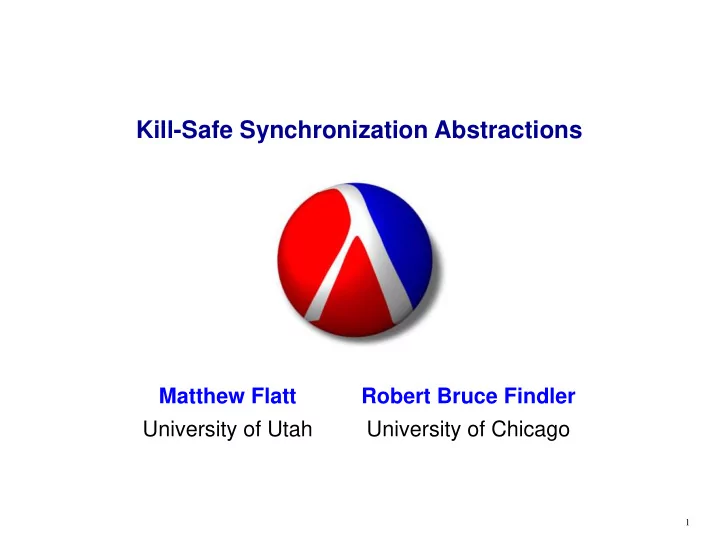

Kill-Safe Synchronization Abstractions Matthew Flatt Robert Bruce Findler University of Utah University of Chicago 1
Sibling Food-Sharing Protocol 2
Sibling Food-Sharing Protocol 3
Sibling Food-Sharing Protocol 4
Sibling Food-Sharing Protocol 5
Sibling Food-Sharing Protocol 6
Sibling Food-Sharing Protocol 7
Sibling Food-Sharing Protocol • By inspection, the protocol is fair • No parental supervision required 8
Sharing among Processes 9
Sharing among Processes 10
Sharing among Processes 11
Sharing among Processes 12
Sharing among Processes • Queue should be safe and fair • Should require no kernel supervision 13
Sharing in Java synchronized 14
Sharing in Java synchronized Thread.stop ⇒ synchronized isn't enough 15
Sharing in Java synchronized Thread.stop ⇒ synchronized isn't enough 16
Sharing in Java synchronized ... Thread.stop ⇒ synchronized isn't enough 17
Sharing in Java synchronized ... Thread.stop ⇒ synchronized isn't enough ∴ Java has no Thread.stop 18
Why Terminate? • Execute code in a programming environment (DrScheme) 19
Why Terminate? • Execute code in a programming environment (DrScheme) • Cancel actions that allocate resources (HTML browser) 20
Why Terminate? • Execute code in a programming environment (DrScheme) • Cancel actions that allocate resources (HTML browser) • Stop misbehaving servlets (web server) 21
Building Kill-Safe Abstractions abstraction abstraction thread-safe thread-safe abstraction abstraction kill-safe kill-safe thread-safe thread-safe abstraction abstraction 22
Building Kill-Safe Abstractions abstraction abstraction Programmer effort — but generally understood thread-safe thread-safe abstraction abstraction kill-safe kill-safe thread-safe thread-safe abstraction abstraction 23
Building Kill-Safe Abstractions abstraction abstraction Programmer effort — but generally understood thread-safe thread-safe abstraction abstraction Programmer effort kill-safe kill-safe — the subject of this talk thread-safe thread-safe abstraction abstraction 24
Building Kill-Safe Abstractions abstraction abstraction Start with Concurrent ML [Reppy 88] thread-safe thread-safe abstraction abstraction kill-safe kill-safe thread-safe thread-safe abstraction abstraction 25
Building Kill-Safe Abstractions abstraction abstraction Start with Concurrent ML [Reppy 88] thread-safe thread-safe abstraction abstraction Add MzScheme's custodians kill-safe kill-safe and a little more thread-safe thread-safe abstraction abstraction 26
Sharing in Concurrent ML 27
Sharing in Concurrent ML 28
Sharing in Concurrent ML 29
Sharing in Concurrent ML Abstraction-as-process naturally supports termination 30
Sharing in Concurrent ML Abstraction-as-process naturally supports termination Remaining problem: who controls the abstraction's process? 31
Managing Processes and Threads 32
Managing Processes and Threads 33
Managing Processes and Threads = custodian = capability to execute 34
Managing Processes and Threads = custodian = capability to execute 35
Managing with Custodians 36
Managing with Custodians 37
Managing with Custodians 38
Managing with Custodians 39
Managing with Custodians Queue terminated with servlet 40
Thread-Safe Abstractions A language to support abstractions: • Concurrent ML primitives for thread communication • Custodians for process hierarchy Each abstraction: • Manager thread for state 41
Towards Kill Safety with Custodians 42
Towards Kill Safety with Custodians 43
Towards Kill Safety with Custodians Not kill-safe among servlets 44
Kill Safety through Joint Custody 45
Kill Safety through Joint Custody 46
Kill Safety through Joint Custody 47
Kill Safety through Joint Custody 48
Kill Safety through Joint Custody Queue runs exactly as long as servlets 49
Why a Thread can have Multiple Custodians 50
Why a Thread can have Multiple Custodians 51
Why a Thread can have Multiple Custodians 52
Why a Thread can have Multiple Custodians 53
Why a Thread can have Multiple Custodians Queue is only mostly dead 54-55
Why a Thread can have Multiple Custodians Queue is only mostly dead 56
Why a Thread can have Multiple Custodians Use queue ⇒ grant custodian 57
Kill-Safe Abstractions A language to support abstractions: • Concurrent ML primitives for thread communication • Custodians for process hierarchy • Operation to grant a thread another custodian Each abstraction: • Manager thread for state • Each action grants custodian to manager thread 58
Non-Solution #1 — Atomic Region = atomic 59
Non-Solution #1 — Atomic Region Queue might harm = atomic other servlets 60
Non-Solution #2 — Disjoint Process 61
Non-Solution #2 — Disjoint Process 62
Non-Solution #2 — Disjoint Process Queue runs forever 63-64
Non-Solution #3 — Meta-Servlet Merely moves the “kernel” 65-66
Solution — Joint Custody 67
Details (See Paper) • Custodians granted through thread-resume • CML's guard-evt a natural place for thread-resume • Improved nack-guard-evt for two-step protocols • Kill-safe does not always imply break-safe, nor vice-versa 68
A Thread-Safe Queue (define-struct safe-q (define (safe-get sq) (put-ch get-ch)) (channel-recv (safe-q-get-ch sq))) (define (safe-queue) (define q (queue)) (define (safe-put sq v) (define get-ch (channel)) (channel-send (define put-ch (channel)) (safe-q-put-ch sq) v)) (define (q-loop) (sync (choice-evt (wrap-evt (channel-send get-ch (peek q)) (lambda () (get q))) (wrap-evt (channel-recv put-ch) (lambda (v) (put q v))))) (q-loop)) (spawn q-loop) (make-safe-q put-ch get-ch)) 69
A Kill-Safe Queue (define-struct safe-q (define (safe-get sq) (manager-t put-ch get-ch)) (resume sq) (channel-recv (define (safe-queue) (safe-q-get-ch sq))) (define q (queue)) (define get-ch (channel)) (define (safe-put sq v) (define put-ch (channel)) (resume sq) (define (q-loop) (channel-send (sync (safe-q-put-ch sq) v)) (choice-evt (wrap-evt (define (resume sq) (channel-send get-ch (peek q)) (thread-resume (lambda () (get q))) (safe-q-manager-t sq) (wrap-evt (current-thread))) (channel-recv put-ch) (lambda (v) (put q v))))) (q-loop)) (define manager-t (spawn q-loop)) (make-safe-q manager-t put-ch get-ch)) 70
Recommend
More recommend